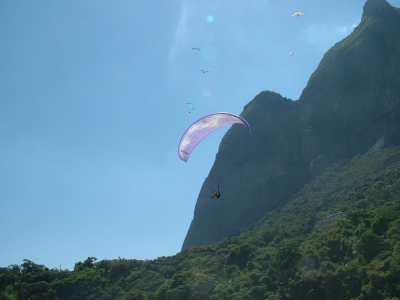
It starts with a handout from one of the optimists on Ipanema beach; a flyer thrust into the unwary hand of the passer-by. Or maybe, it starts with a signature in a log book a month earlier declaring that the owner is now an Elementary Pilot. Or even earlier, when said Elementary Pilot looks into the sky and thinks 'I can do that...'
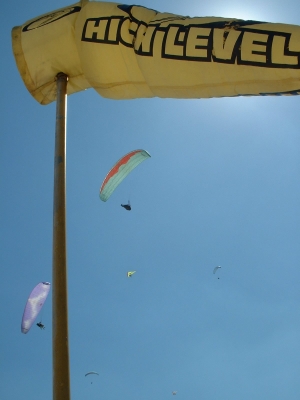
Whichever, the result is that I look at the advertising flyer. Paraglider and hang glider flights, tandem from Pedra Bonita. Start at five hundred metres, glide down to the beach - Praia de Pepino - a quarter of an hour later, and all under the auspices of the Brasilian free-flight association and the Rio de Janeiro free-flight club.
But then I screw it up and throw it away. Well of course I do. I don't want to be ferried around, I want to drive. That's what I've been working so hard last summer to achieve - and believe me, there's nothing as frustrating as taking three months to find five trainable days. And besides, there's the New Year and such like things to get out of the way, first...

Yet somehow thoughts keep coming back to it. What was the main problem when I was training? Taking half of each day trying to remember the painful lessons I'd managed to forget since the last lesson. Maybe, just maybe, I could get some training while I was here? There were still a few days before I had to fly back to the UK...
The internet is a wonderful thing. It didn't take long to discover several instructors offering courses for the Brasilian qualifications; pilot levels one and two. The first seems to be roughly equivalent to half-way between EP and CP. Phone calls were made, emails were sent... and replies were not forthcoming. New Year holidays, perhaps.
Still, I didn't lose heart. I had by this time discovered that Praia de Pepino was the headquarters for the Rio flying club and the logical place to seek instructors. It has to be said that, at first, the concept of someone seeking instruction was something of a shock to the local tandem pilots. Fair enough - these guys do the flights for a living and have to earn enough across a very short season, effectively Christmas to Carnival, to survive the rest of the year - but eventually I was directed to the inimitable Millan. I still haven't worked out quite how the networks are joined together, but from him I was introduced to Paulo Pinto and Luis Gonçalves of Gavea Skywalkers.
Paulo - a test pilot instructor and ex-presidential pilot - has very good English and spent some time talking with me to establish my probable skills. He explained the training process, and deciding that I was OK on the basic knowledge, started me again with ground handling.
Damn, but six weeks ago I could do this stuff. This time I couldn't. Inflate, check, run. On a flat ground, at 36°C, with absolutely no wind? Just a little bit different from the south of England... Luis shouted himself hoarse. "Look up, not over your shoulder!" "Position one, two, three... two, three, two, three, RUN!" "Inflate, stabilise, RUN!"
After two afternoon sessions of this, each lasting maybe three hours, my body was becoming radically more aerodynamic - or at least, lighter - and I could get the wing up and keep it there. I had a couple of new launch techniques, and I could even run fast enough to get almost airborne, too...
The next day things got more exciting. Remember short hops? Here's a good rule to remember: when Montezuma wants his revenge, don't try and fly. It's a bad combination.
The site was about an hour south of São Conrado, at Paciencia. A small hill offers various launch heights, with the experts using the 70-80 metre ridge to launch and soar. I started at about twenty metres, and over the next three days made around twenty or twenty five short flights - each session lasted around a couple of hours, and involved what felt like an incredible amount of walking back and recovering from the walk. Temperatures were up to 40 degrees, even though we started flying as soon after nine as we could; walking up that hill any more often would have been pretty much impossible. Still; I got what I wanted - lots and lots of practice.
One thing I did learn about that site; the high temperatures and exposed dry ground make it a lot different from English conditions. The launch was not difficult, with the light wind blowing generally up the hill, and there was a nice and reasonably flat landing zone - provided I could reach it. However, the experts will have already realised that the conditions were ideal for little thermals to form, and usually they did it just where I didn't want them to. A gully before the landing zone faced right into the sun, and if I was lucky I could get enough lift there to take me over it - but sometimes the sink before - and particularly after I passed through it - were vicious, and not at all what you want just as you're landing. Very different from nice smooth grass! Other hazards included the mobile kind; curious horses and cows with nice sharp horns would occasionally wander across to see what was going on, and the folk flying from the top of the hill would occasionally be confused by the wind and end up where I wanted to fly. The land itself looked fine from the top of the hill, but as it approached I'd see ridges, holes, and gullies concealed in the sparse grass cover; I soon learned that I was better off aiming for the bare earth, where there were at least fewer hiding places.
Video of me flying: 3.5Mbyte download.
The final day - and the day before I was due to fly home - should have been the big one. The intention was to get one flight from twenty metres, a longer flight from seventy metres, and a tandem or two with Paulo handling the take-off and landing from the Pepino launch point. Then - and only then - would I be allowed a solo from Pepino.
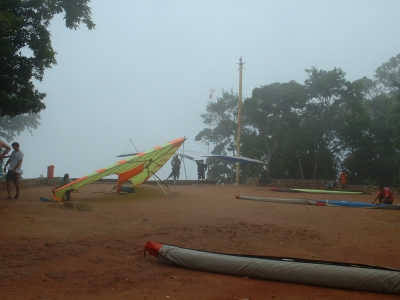
I'd been up to Pepino a few years before, taken a look down the hang glider launch, and thought 'uh-oh, no thank-you!' From the top, there's a wooden platform with about a one-in-five slope, a few metres long and maybe ten or twelve metres wide. There's nothing visible from the top of it except sky. When it's busy, all you hear is "Run!", thud thud thud thud... and another hang glider and passenger disappears into the sky. The paraglider launch is below the ramp, on a patch of grass one paraglider wide, one paraglider deep. When the wing's laid out, from the end of the risers there's a strip of carpet - for grip; you wouldn't want to do this on wet grass - with the width and fall of a flight of stairs. You have a maximum of six steps to get airborne, and after that, well, you're airborne anyway. It's a long way down to the rain-forest, and it's pretty much vertical for the first hundred metres or so. You have no choices: you must be able to get your wing up; you must be able to steer it accurately as you run, and you must be able to get it flying in six steps. The experts make it look easy, but for a novice it's a little bit daunting. Hence all the emphasis on take off skill...
Which was no use at all to me. The day was nice and sunny again, but the wind was high and gusty. More in hope than expectation, Paulo took me and another student to the Paciencia site, but when we arrived there there was nothing doing. We checked all the options around the site, but the wind was too high and too gusty - and blowing from the wrong direction even to get a chance of a tandem from Pepino. So instead, we ended up with a guided tour of Paulo's old air base, and went to see the hangar where Zeppelins used to land in the thirties.
Later that afternoon it rained, then cleared up. Tomorrow I would fly back home - twenty-odd hours via São Paulo and New York - and had to be at the airport for six p.m. But - brainwave! - perhaps there was still a chance for a tandem flight, even though I wouldn't go solo?
Phone call to Millan. He'd arrived home for the day, but told me to call him in the morning. Came the dawn, and the sky was overcast, cloud base at fifty metres, light intermittent rain. Not hopeful. Still, I made the call. Millan tells me the forecast is for things to get better; call later.
I did. Twice. At twelve o'clock, Millan tells me we're hot to trot. Get my backside over to Praia de Pepino and meet him there. We get there, and the cloud's lifted to about four hundred and fifty metres; the launch point is still covered. Still, the rumour of possible flights seems to be firm. All around us, the hang glider pilots are collecting passengers and fixing their gliders to roof-racks. Millan introduces me to a German pilot, Alfred, who will be making his first flight from Pepino, and we disappear into the misty forest.
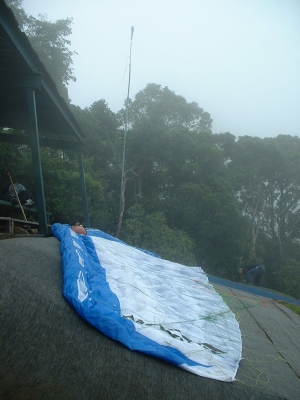
Ten minutes later we're at the summit. Tokens are exchanged to indicate that we've paid the necessary ten Reais (about two pounds) to be allowed to use the site, and the first wing is laid out. The beach is still invisible; there's a very gentle wind moving in the right direction, but it's taking its time shifting the cloud. It's obvious that it's lifting, though... slowly we become able to see Rio in the distance, and the tiny triangle of green that is the landing zone. The first hang glider decides to go, somewhat to the surprise of his passenger...

"Run!" Thud thud thud thud..."Oh **** nooooooooooo!" and they're off... A couple more hang gliders go. The cloud has lifted a little further, and Millan negotiates with the hang gliders for a launch. Alfred, suited and booted, takes his leave of us with a most elegant launch; the wing snaps up and he's away.
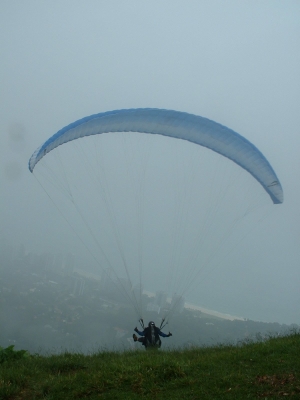
Our turn. Millan briefs me on the take-off procedure, reminds me not to stop running, yells "Go!" and we're off...
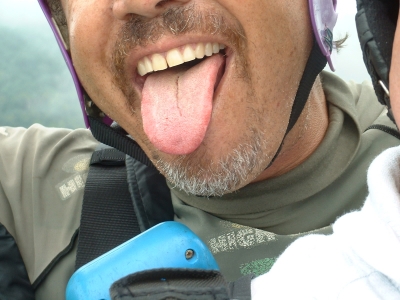
Instantly, it seems, we're out of the remaining wisps of cloud. The higher summits around us remain hidden, and there's no sun. Millan makes a couple of big lazy S-turns for photos as we lose height, then we head for the coast.
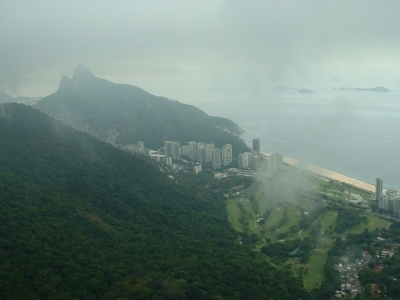
"You have control." "I have control."
I have control... fantastic. At last I am able to do what I've been working for. Millan instructs me on the way down and we head to where there might be some lift. We work along a short ridge and pick up a little, but not enough to stop us going down. The wing is heavy - much heavier to turn than anything I've used before - but surprisingly agile for something like forty-four square metres. It's not long before I'm making rapid 180 and 360 turns, taking it where Millan instructs me.
Maybe fifteen or twenty minutes later - not long enough, in my humble opinion - we have to land. Hang gliders - according to the club rules - indicate their intention to land by dropping below the height of the buildings that line the beach, and then fly an orbit; downwind over the water, turn right, and into the wind to land on the beach or the grass. Paragliders lose height over the water and fly to the grass past the end of the hang glider orbit. Occasionally one will land on the beach.
We make a couple of final 360s and Millan shuffles alongside me for the landing. We discover my legs are thirty centimetres nearer the ground than his... oh well. As we unhook I discover I can't get the helmet off over my grin.
As the plane approaches touch down for the first stop in São Paulo, Anita and I look at each other and simultaneously say "And flare!" and promptly burst into fits of giggles as the wheels hit the tarmac.
I'll be back next year. I will do that launch solo. And in the meantime, I hope Andy at Green Dragons still has the patience to get me through the CP...